Bipolar disorder is a common illness characterised by recurrent episodes of mania and major depression. The lifetime prevalence of bipolar disorder is between 1% and 2% (Reference Bebbington and RamanaBebbington & Ramana, 1995). Moreover, bipolar disorder is often associated with other mental disorders, particularly alcoholism and substance misuse (Reference Regier, Farmer and RaeRegier et al, 1990). Bipolar disorder places a substantial burden on primary and secondary health-care sectors as well as other statutory services (Office for National Statistics, 1995; Reference Onyett, Heppleston and BushnellOnyett et al, 1995); however, the socio-economic impact of bipolar disorder on UK society is unknown. Against this background we estimated the annual cost imposed by bipolar disorder on UK society.
METHOD
Perspective
This evaluation estimated:
-
(a) the annual costs of managing bipolar disorder from the perspective of the National Health Service (NHS);
-
(b) the annual costs resulting from bipolar disorder borne by other statutory agencies, such as local authorities and the criminal justice system; and
-
(c) the indirect annual costs to society due to unemployment, absenteeism from work and premature mortality.
Primary care resource use
The DIN-link database contains information on 0.9 million live patients managed by approximately 360 general practitioners (GPs) in 100 nationally distributed general practices (using AAH Meditel System 5 clinical software, version 5.7.x for UNIX; now System 5, Torex Health, Bromsgrove, Worcestershire, UK). The database was interrogated to obtain the annual amount of primary care resource use (i.e. GP consultations, GP-prescribed drugs and GP-initiated diagnostic tests) between 1 January 1998 and 31 December 1998 attributable to managing bipolar disorder. Patients were included if they had a note entry of one of the following Read codes, together with an addition or amendment to their case notes in the study year, indicating that they were still registered with their GP: hypomania/mania (E221); other manic—depressive psychoses (E22Z); affective psychoses (E22). The resource use estimates derived from the DIN-link database were extrapolated to the whole of the NHS by multiplying by a factor of 75, which takes into account the size of the data-set population relative to that of the whole UK and the relative underrecording of certain data items when the database is cross-referenced against other sources (Reference MartinMartin, 1995).
Secondary care in-patient resource use
Hospital in-patient data were based on the IBM Hospital Episode Statistics database, which contains information compiled from the statutory returns from the 300 trusts in England. The database was interrogated to obtain the annual number of hospital episodes attributable to bipolar disorder in accordance with the diagnostic codes of ICD-10 (World Health Organization, 1992) (i.e. F31.0-F31.9 for 1995/96 to 1997/98). Patients were included in the data-set if they had a primary diagnosis of bipolar disorder between 1 April 1995 and 31 March 1998. Results were extrapolated to the whole UK by multiplying by 1.2 (i.e. the ratio of the population of the UK to that of England).
Other health care resource use
Published sources were used to provide information on resource utilisation by psychiatric patients using NHS day hospitals (Department of Health, 1999a ), out-patient services (Department of Health, 1999b ), community mental health teams (CMHTs; Reference Onyett, Heppleston and BushnellOnyett et al, 1995) and special (high-security) hospitals (Department of Health, 2000a , c ). This was supplemented with information obtained from interviews with ten NHS consultant psychiatrists who had experience of people with bipolar disorder.
Personal social service resource use and the criminal justice system
Data were obtained on resource utilisation by people with bipolar disorder using residential services (D. Chisholm, personal communication, 1999), the criminal justice system (Stationery Office, 2000a ) and non-NHS day care facilities (Department of Health, 1998), the latter being supplemented with information obtained from telephone interviews with managers at seven non-NHS day care facilities.
Resource costs
Unit resource costs were obtained (D. Chisholm, personal communication, 1999; Reference Netten, Dennett and KnightNetten et al, 1999; Haymarket Publications, 2000; Stationery Office, 2000b ) and, where necessary, uprated to 1999/2000 prices using the Health Service Inflation Index (Reference Netten, Dennett and KnightNetten et al, 1999). By assigning these costs to the resource use estimates, the annual direct cost attributable to bipolar disorder was calculated at 1999/2000 prices.
Indirect resource use and costs
The indirect cost arising from excess unemployment (Reference Gareth Hill, Hardy and ShepherdGareth Hill et al, 1996), absenteeism from work (Reference Lepine, Gastpar and MendlewiczLepine et al, 1997) and suicide (Reference Sharma and MarkarSharma & Markar, 1994) among individuals with bipolar disorder was estimated using the human capital approach (Reference Drummond, O'Brien and StoddartDrummondet al, 1998), by applying the current annual average wage (Office for National Statistics, 2000) to the estimated number of people with bipolar disorder absent from work as a result of morbidity and mortality. A 6% annual discount rate was applied to the indirect costs of unemployment arising from people with bipolar disorder who commit suicide in the study year and, therefore, who are absent from the workforce in subsequent years.
Sensitivity analysis
Univariate sensitivity analyses tested the robustness of the study results to changes in resource use activity affecting health-care, non-health-care and indirect costs.
RESULTS
National Health Service resource use
The DIN-link database
The DIN-link database contained data on 1807 patients with bipolar disorder in 1998, equivalent to approximately 136 000 people with bipolar disorder being registered with a GP during that year. The mean age of people with bipolar disorder in the DIN-link data-set was 54 years. Of these, 62% were female and 38% were male. Additionally, patients aged <21 years accounted for <1% of the total number of patients in the DIN-link data-set.
GP consultations
Based on all the people with bipolar disorder in the DIN-link database, it was estimated that there were 315 000 GP consultations attributable to bipolar disorder during 1998. Hence, the annual cost of GP consultations attributable to bipolar disorder was estimated to be £5.2 million.
GP-prescribed drugs
Fifty-eight per cent of patients in the DIN-link data-set received medication for bipolar disorder prescribed by their GP during 1998. This corresponds to an estimated 79 125 patients receiving approximately 1.2 million GP-prescribed items during the study year (Table 1). These GP-prescribed drugs cost £8.5 million.
Table 1 Annual number and corresponding cost of general practitioner-prescribed drugs for bipolar disorder
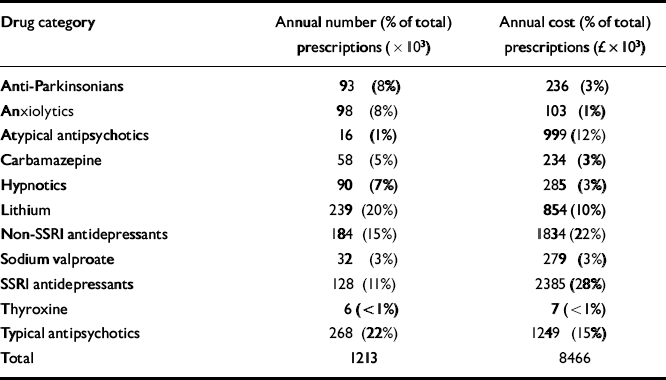
| Drug category | Annual number (% of total) prescriptions (× 103) | Annual cost (% of total) prescriptions (£ × 103) |
|---|---|---|
| Anti-Parkinsonians | 93 (8%) | 236 (3%) |
| Anxiolytics | 98 (8%) | 103 (1%) |
| Atypical antipsychotics | 16 (1%) | 999 (12%) |
| Carbamazepine | 58 (5%) | 234 (3%) |
| Hypnotics | 90 (7%) | 285 (3%) |
| Lithium | 239 (20%) | 854 (10%) |
| Non-SSRI antidepressants | 184 (15%) | 1834 (22%) |
| Sodium valproate | 32 (3%) | 279 (3%) |
| SSRI antidepressants | 128 (11%) | 2385 (28%) |
| Thyroxine | 6 (<1%) | 7 (<1%) |
| Typical antipsychotics | 268 (22%) | 1249 (15%) |
| Total | 1213 | 8466 |
The mean annual cost of GP-prescribed medication was £107 per patient receiving medication. This corresponds to a mean annual cost of £249 per GP and £809 per general practice for medication for bipolar disorder.
GP-initiated tests
People with bipolar disorder undergo a mean 111 000 tests per year. These include blood drug levels, biochemistry tests, thyroid function tests and haematology tests, costing the NHS £1.2 million annually.
In-patient episodes
Between 1 April 1997 and 31 March 1998 there were 12 400 annual hospital episodes for bipolar disorder in the UK, costing £69 million. These episodes accounted for 4% of the 290 019 annual episodes for mental health (Department of Health, 2000a ). From the interviews it was estimated that about 30% of these episodes would result in a patient being transported to a hospital by ambulance, costing the NHS £670 000 annually. Table 2 summarises these data, stratified by different specialities.
Table 2 Annual number of hospital episodes and corresponding costs attributable to bipolar disorder
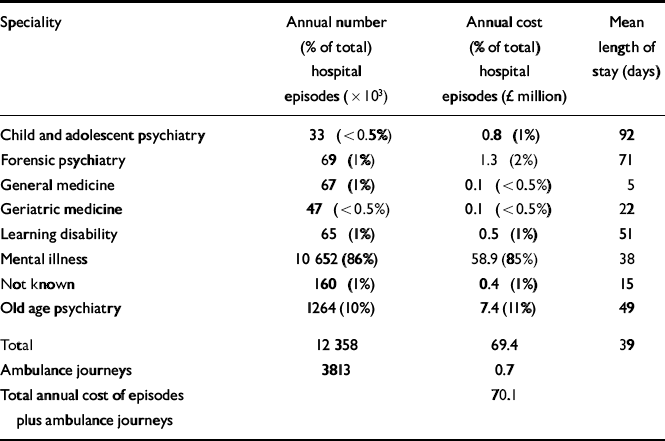
| Speciality | Annual number (% of total) hospital episodes (× 103) | Annual cost (% of total) hospital episodes (£ million) | Mean length of stay (days) |
|---|---|---|---|
| Child and adolescent psychiatry | 33 (<0.5%) | 0.8 (1%) | 92 |
| Forensic psychiatry | 69 (1%) | 1.3 (2%) | 71 |
| General medicine | 67 (1%) | 0.1 (<0.5%) | 5 |
| Geriatric medicine | 47 (<0.5%) | 0.1 (<0.5%) | 22 |
| Learning disability | 65 (1%) | 0.5 (1%) | 51 |
| Mental illness | 10 652 (86%) | 58.9 (85%) | 38 |
| Not known | 160 (1%) | 0.4 (1%) | 15 |
| Old age psychiatry | 1264 (10%) | 7.4 (11%) | 49 |
| Total | 12 358 | 69.4 | 39 |
| Ambulance journeys | 3813 | 0.7 | |
| Total annual cost of episodes plus ambulance journeys | 70.1 |
Table 2 shows that 86% and 10% of episodes are admitted to mental illness beds and old age psychiatry beds, respectively. Furthermore, mental illness and old age psychiatry accounted for 85% and 11%, respectively, of the costs of hospital care for bipolar disorder.
Forty-four per cent of the hospitalisation costs attributable to bipolar disorder were due to patients suffering from either mania or hypomania without psychotic symptoms, 27% to patients suffering from depression without psychotic symptoms, 16% to those suffering from mania with psychotic symptoms, 6% to patients suffering from depression with psychotic symptoms, 8% to those with a mixed episode, 3% to those in remission and 2% to other bipolar disorders.
The estimated mean annual number of hospital in-patient episodes per person with bipolar disorder was greater among the 25-to 34-year age group, at seven episodes per year per 100 patients (equivalent to almost two-thirds of all the in-patient episodes), and was seven times greater than the annual number of episodes per patient in the <16— and >84-year age groups. Generally, the annual number of hospital in-patient episodes per patient decreased with age among patients over 34 years of age. Additionally, the percentage of episodes associated with manic and hypomanic symptoms decreased with age. Conversely, proportionally more episodes were associated with depressive symptoms as patients' age increased.
Out-patient and ward attendances
Approximately 2 million annual psychiatric out-patient attendances are conducted under the auspices of mental illness and psychiatry of old age in the UK (Department of Health, 1999b ), of which 14% was estimated to be because of bipolar disorder. Hence, it was estimated that a mean 277 000 attendances a year are attributable to bipolar disorder, costing £28.5 million.
There are a mean 96 000 annual psychiatric ward attendances in the UK (Department of Health, 1999b ), of which 5% was estimated to be because of bipolar disorder. This suggests that there are a mean 5000 attendances a year attributable to bipolar disorder, costing £0.5 million.
Community mental health team contacts
The annual cost of CMHTs in the UK was estimated to be £380 million. Fourteen per cent of total CMHT contact was estimated to be because of bipolar disorder, corresponding to an annual cost of £53.2 million.
NHS day hospital attendances
There are approximately 4.6 million attendances at psychiatric day hospitals annually in the UK (Department of Health, 1999a ), of which 10% was estimated to be because of bipolar disorder. This corresponds to about 459 000 attendances a year, costing £28.9 million.
Special hospitals
The approximate 1350 beds managed by the three high-security hospital authorities in the UK cost the NHS £135.2 million in 1999/2000 (Department of Health, 2000a ). Based on data from a study of admissions to one special hospital in 1987/88 (Reference Gunn, Maden and SwintonGunn et al, 1991), this analysis assumed that 2% of in-patients are admitted because of bipolar disorder, costing the NHS an estimated £2.7 million in 1999/2000.
Total annual NHS cost
The total annual health-care cost attributable to managing bipolar disorder was estimated to be £199 million (Table 3).
Table 3 Annual National Health Service (NHS) costs attributable to bipolar disorder
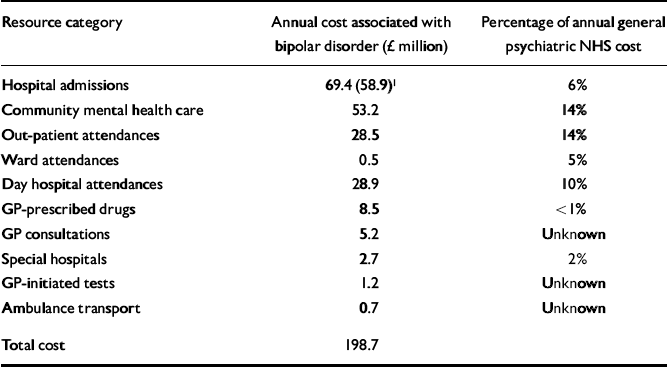
| Resource category | Annual cost associated with bipolar disorder (£ million) | Percentage of annual general psychiatric NHS cost |
|---|---|---|
| Hospital admissions | 69.4 (58.9)1 | 6% |
| Community mental health care | 53.2 | 14% |
| Out-patient attendances | 28.5 | 14% |
| Ward attendances | 0.5 | 5% |
| Day hospital attendances | 28.9 | 10% |
| GP-prescribed drugs | 8.5 | <1% |
| GP consultations | 5.2 | Unknown |
| Special hospitals | 2.7 | 2% |
| GP-initiated tests | 1.2 | Unknown |
| Ambulance transport | 0.7 | Unknown |
| Total cost | 198.7 |
Residential care
People with bipolar disorder were estimated to occupy 4822 places in residential accommodation, costing £67.8 million. Table 4 summarises these data, stratified by home type.
Table 4 Residential care in the UK for people with bipolar disorder
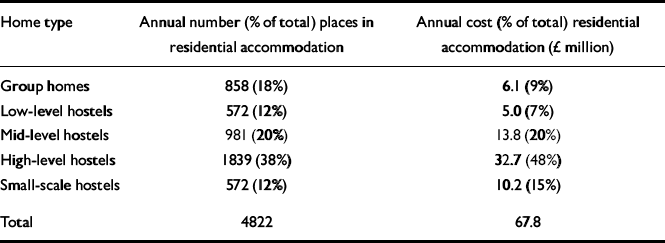
| Home type | Annual number (% of total) places in residential accommodation | Annual cost (% of total) residential accommodation (£ million) |
|---|---|---|
| Group homes | 858 (18%) | 6.1 (9%) |
| Low-level hostels | 572 (12%) | 5.0 (7%) |
| Mid-level hostels | 981 (20%) | 13.8 (20%) |
| High-level hostels | 1839 (38%) | 32.7 (48%) |
| Small-scale hostels | 572 (12%) | 10.2 (15%) |
| Total | 4822 | 67.8 |
Non-NHS day care attendances
There are approximately 4.7 million attendances annually at non-NHS day care facilities in the UK by people with a mental illness (Department of Health, 1998), of which 16% was estimated to be because of bipolar disorder. This corresponds to an estimated 754 000 attendances a year, costing £18.1 million.
Criminal justice system
We were unable to find any published evidence that the incidence of either imprisonment or people on remand was higher among those with bipolar disorder than in the general population. Therefore, this analysis assumed that the cost incurred by the criminal justice system attributable specifically to bipolar disorder is zero.
Indirect societal costs
Indirect costs due to excess unemployment among people with bipolar disorder
The prevalence of bipolar disorder in the UK was estimated to be 0.5% (Reference Bebbington and RamanaBebbington & Ramana, 1995), which is similar to the lifetime risk and annual prevalence rates and equates to approximately 297 000 people with bipolar disorder in the UK annually. The unemployment rate among people with bipolar disorder was estimated to be 46%, of whom 60% are available for work (Reference Gareth Hill, Hardy and ShepherdGareth Hill et al, 1996). This compared with an unemployment rate among the general population in the UK in 1999/2000 of 3% (Office for National Statistics, 2000). Hence, an excess of 76 500 people annually are unemployed as a result of having bipolar disorder. Therefore, the annual indirect cost due to excess unemployment among people with bipolar disorder was estimated to be £1510 million at 1999/2000 prices.
Indirect costs due to absenteeism from work among people with bipolar disorder
The rate of excess absenteeism from work among those with major depression compared with those without depression was estimated to be about 9 days over a 6-month period in the UK (Reference Lepine, Gastpar and MendlewiczLepine et al, 1997). Assuming that all of these subjects were in full-time employment, this suggests an excess absenteeism rate of 8%. By assuming comparable absenteeism from work among the UK's estimated 96 300 people with bipolar disorder who are employed (Reference Kind and SorensenKind & Sorensen, 1993), the associated indirect cost would be £152 million per year at 1999/2000 prices.
Indirect costs due to suicide
The annual incidence of bipolar disorder is 0.009% and 0.0096% for males and females, respectively (Reference Bebbington and RamanaBebbington & Ramana, 1995). Hence, there are 4454 new cases of bipolar disorder diagnosed in the UK annually. The suicide rate among people with bipolar disorder is 1.5% annually for the first 10 years following diagnosis (Reference Sharma and MarkarSharma & Markar, 1994). This equates to an excess of 640 suicides because of bipolar disorder annually, with an associated indirect cost of £179 million undiscounted or £109 million discounted.
Indirect costs due to carers
A review of the published literature did not identify any evidence that there was a higher unemployment rate among carers than the general population; therefore, it was estimated that there are no indirect costs specifically attributable to carers of people with bipolar disorder.
Total annual societal cost of bipolar disorder
The total annual societal cost of bipolar disorder in 297 000 people was estimated to be £2055 million annually (Table 5) or approximately £ 6919 per person with bipolar disorder.
Table 5 Total annual societal cost attributable to bipolar disorder
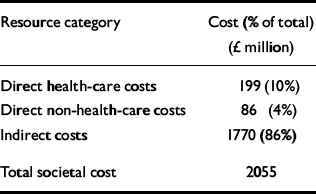
| Resource category | Cost (% of total) (£ million) |
|---|---|
| Direct health-care costs | 199 (10%) |
| Direct non-health-care costs | 86 (4%) |
| Indirect costs | 1770 (86%) |
| Total societal cost | 2055 |
Sensitivity analyses
Health care costs
Sensitivity analyses (Table 6) showed that doubling the annual number of in-patient episodes and CMHT contacts would increase the annual NHS cost of managing bipolar disorder by 35% and 27%, respectively. Conversely, halving the annual number of in-patient episodes and CMHT contacts would reduce the annual NHS cost of managing bipolar disorder by 18% and 13%, respectively. However, the annual NHS cost is not sensitive to changes in the use of any other health care resource.
Table 6 Sensitivity analyses on National Health Service resource categories

| Scenario | Range of annual NHS cost (£ million) |
|---|---|
| Annual number of GP consultations, GP-initiated tests and GP-prescribed drugs is reduced by 50% and increased by 100% above/below baseline | 191-214 |
| Annual number of hospital in-patient episodes is reduced by 50% and increased by 100% above/below baseline | 164-269 |
| Annual number of out-patient and ward attendances is reduced by 50% and increased by 100% above/below baseline | 185-227 |
| Annual number of CMHT contacts is reduced by 50% and increased by 100% above/below baseline | 172-252 |
| Annual number of day hospital attendances is reduced by 50% and increased by 100% above/below baseline | 184-228 |
| Annual number of in-patients in special hospitals is reduced by 50% and increased by 100% above/below baseline | 198-202 |
Non-health-care direct costs
Sensitivity analyses (Table 7) showed that doubling of the annual number of residential places would increase the annual non-health-care cost of managing bipolar disorder by 79%. Conversely, halving the annual number of residential places would reduce the annual non-health-care cost of managing bipolar disorder by 39%. The annual non-health-care cost attributable to bipolar disorder is also sensitive to the assumptions pertaining to the use of the criminal justice system by people with bipolar disorder. If people with bipolar disorder made twice as much use of the criminal justice system as the general population, the annual non-health-care cost of managing bipolar disorder would increase by 91%. Conversely, if people with bipolar disorder made half as much use of the criminal justice system as the general population, the annual non-health-care cost of managing bipolar disorder would decrease by 45%. However, the annual non-health-care cost of managing bipolar disorder is not sensitive to changes in the annual number of non-NHS day care attendances.
Table 7 Sensitivity analyses on non-health-care resource categories
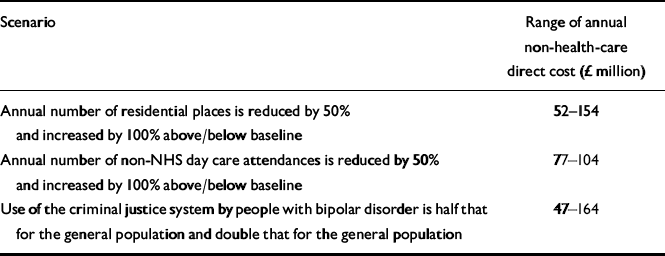
| Scenario | Range of annual non-health-care direct cost (£ million) |
|---|---|
| Annual number of residential places is reduced by 50% and increased by 100% above/below baseline | 52-154 |
| Annual number of non-NHS day care attendances is reduced by 50% and increased by 100% above/below baseline | 77-104 |
| Use of the criminal justice system by people with bipolar disorder is half that for the general population and double that for the general population | 47-164 |
Indirect costs
Sensitivity analyses (Table 8) showed that doubling of the annual number of unemployed people with bipolar disorder would lead to an 83% increase in the annual indirect cost attributable to bipolar disorder. Conversely, a 50% reduction in the annual number of unemployed people would lead to a 43% decrease in the annual indirect cost attributable to bipolar disorder. However, the annual indirect cost attributable to bipolar disorder is not sensitive to changes in the excess rate of absenteeism from work or in the annual number of suicides.
Table 8 Sensitivity analyses on indirect costs

| Scenario | Range of annual indirect cost (£ million) |
|---|---|
| Annual number of unemployed people with bipolar disorder is reduced by 50% and increased by 100% above/below baseline | 1016-3280 |
| Excess rate of absenteeism from work among people with bipolar disorder is reduced by 50% and increased by 100% above/below baseline | 1695-1922 |
| Annual number of suicides attributable to bipolar disorder is reduced by 50% and increased by 100% above/below baseline | 1716-1880 |
DISCUSSION
Cost of illness studies provide information about patterns of resource use associated with a particular condition, thereby enabling a greater understanding of the framework in which decisions about resource allocation are made. However, cost of illness studies, unlike cost-effectiveness and cost utility studies, are unable to directly inform decisions about the effective allocation of resources to fund particular treatments or strategies.
Uncertainty
In this analysis there is considerable uncertainty surrounding the prevalence of bipolar disorder in the UK because of the lack of robust epidemiological surveys. Community-based psychiatric surveys in other countries estimate the total prevalence of bipolar disorder to be 1.0-2.5%, which is substantially higher than the number of people treated for bipolar disorder (Reference Bebbington and RamanaBebbington & Ramana, 1995). Also, there may be a high level of unmet need, although some patients may develop coping strategies or endure symptoms below the thresholds for treatment, given the current risk—benefit ratios of available drugs. Finally, the variation in diagnostic threshold can contribute to the uncertainty surrounding the prevalence of bipolar disorder (Reference AkiskalAkiskal, 1996).
This analysis used interviews with psychiatrists and managers of day care facilities to estimate the percentage of their workload that was associated with managing people with bipolar disorder. In the hierarchy of evidence, such expert opinion is the least reliable compared with, for example, randomised control trials (Reference Stevens, Raftery, Stevens and RafteryStevens & Raftery, 1994), but in the absence of relevant published data this was the only suitable method with which to model these resource items. However, the estimated percentage of psychiatric out-patient workload and CMHT workload attributable to bipolar disorder was comparable to that reported by others (Reference Onyett, Heppleston and BushnellOnyett et al, 1995; National Health Service in Scotland, 1999).
The prevalence of bipolar disorder among patients in the DIN-link database was about 0.25%. This was comparable with the 0.5% prevalence assumed in our study (Reference Bebbington and RamanaBebbington & Ramana, 1995). However, some patients may be managed almost exclusively in secondary care, whereas others may not receive any health care. Furthermore, some people with bipolar disorder may have been misdiagnosed under a Read code that was not included in the DIN-link data-set. The estimated prevalence of people with bipolar disorder who attend psychiatric out-patient services is between 0.12 and 0.24%, although the proportion of these patients in contact with their GP is unknown.
Sensitivity
The annual health care cost attributable to bipolar disorder is most sensitive to changes in the number of hospital admissions and CMHT contacts. However, there is little uncertainty about the annual number of hospital admissions, which was derived from statutory Department of Health returns, although some people with bipolar disorder may have been excluded from our analysis, such as those who have only one manic episode not followed by a depressive episode. The estimated cost of CMHT contacts made use of the survey by Onyett et al (Reference Onyett, Heppleston and Bushnell1995), which examined the organisation and operation of CMHTs in England. The structure of CMHTs may have changed since this survey was performed, but we were unable to find more recent published data on the structure of CMHTs to inform our analysis. Therefore, there remains some uncertainty surrounding the cost of CMHT contacts pertaining to bipolar disorder. The annual non-health-care cost attributable to bipolar disorder is most sensitive to changes in the number of residential places. However, there is little uncertainty about the annual number of residential places, which was derived from a database used in a study by Chisholm (D. Chisholm, personal communication, 1999). The annual non-health-care cost is also sensitive to changes in the assumptions about the number of contacts made by people with bipolar disorder with the criminal justice system. A Swiss study suggested that people with bipolar disorder were between two and three times more likely to engage in criminal activity than the general population (Reference Modestin, Hug and AmmannModestin et al, 1997). However, we found no evidence suggesting an increased risk of imprisonment among people with bipolar disorder in the UK. This discrepancy is worthy of further investigation.
The annual indirect cost attributable to bipolar disorder was sensitive to changes in the number of unemployed people, which was based on a survey of those in the Manic Depression Fellowship. However, the membership of the Fellowship may not be representative of all people with bipolar disorder. The baseline indirect costs in our study relate to people receiving treatment for bipolar disorder. Including untreated cases could substantially increase the indirect costs. However, because such people have not presented to the medical services, they may not exhibit the same level of morbidity and mortality as those who do present. Nevertheless, they may still endure reduced functioning and accrue costs.
We estimated that 640 people with bipolar disorder commit suicide annually. This is equivalent to about 11% of the 5905 suicides in the UK per year (Reference Ray, Borton and CoylesRay et al, 1998). Additionally, in one survey of people with bipolar disorder, 47% reported at least one attempted suicide (Reference Gareth Hill, Hardy and ShepherdGareth Hill,et al, 1996). In comparison, the annual number of deaths because of depression was estimated to be 2600 (Reference Gareth Hill, Hardy and ShepherdGareth Hill et al, 1996).
Study limitations
Primary care resource use was based on the DIN-link database. However, limitations in diagnostic categories may mean that some patients included in the data-set may have been suffering from unipolar psychosis. Nevertheless, it was assumed that all patients with a diagnostic code of ‘affective psychosis’ suffer from bipolar disorder. Furthermore, patients with other conditions, such as schizophrenia and schizoaffective disorder, may have been included under the diagnostic categories for ‘mania and hypomania’, reflecting the difficulties in making a differential diagnosis for this disorder.
The cost of drugs used to treat bipolar disorder constitutes less than 2% of the total cost of GP prescribing for all psychiatric conditions (Department of Health, 2000d ) and about 5%, 14% and 14% of general psychiatric in-patient, out-patient and general community team costs, respectively (Department of Health, 2000d ). Treatment choices are particularly important in patients with bipolar disorder where compliance with conventional maintenance treatment is low (Reference Keck, McElroy and StrakowskiKeck et al, 1997). Some atypical antipsychotics have been shown to have antimanic properties (Reference Tohen and GrundyTohen & Grundy, 1999; Reference Keck, McElroy and StrakowskiKeck et al, 2000) and a lower risk of extrapyramidal symptoms than is associated with typical antipsychotics (Reference Miller, Yatham and LamMiller et al, 2001), potentially leading to improved compliance. The cost of drugs prescribed by psychiatrists in out-patient clinics has not been included in the present analysis. However, because most drugs are prescribed and dispensed in the community, this is unlikely to lead to a substantial difference in the annual drug cost. Moreover, the estimated annual primary care drug cost of £8.5 million for people with bipolar disorder is small compared, for example, with the drug costs for schizophrenia for England in 1992/93. These were estimated to be about £32 million (£39 million at 1999/2000 prices) (Reference KnappKnapp, 1997).
A number of services have not been costed in this study, including a work rehabilitation scheme provided by the NHS, referrals to either a psychotherapist or clinical psychologist and attendances at a drug or alcohol dependency service. The associated costs of these are likely to be proportionally very low and within our sensitivity analyses. All these services are provided within the NHS and form part of the care provided by out-patient clinics, CMHTs or day hospitals, and our baseline estimates are likely to include some of these costs. The analysis also excluded the intangible costs of patients and their families. The psychological burden of living with bipolar disorder and its disruptive effect on daily living affects the usual activity of patients and their families (Reference Onyett, Heppleston and BushnellOnyett et al, 1995). Such activity may not involve paid employment and is difficult to quantify.
Comparison with schizophrenia
Compared with schizophrenia, bipolar disorder is a neglected disease. This is true if one compares research output in academic journals on the one hand and NHS planning documents on the other. The present study illustrates that bipolar disorder costs less than schizophrenia: £2 billion compared with £ 3.7 billion at 1999/2000 prices. In-patient care for schizophrenia accounts for over 90% of the annual direct health care cost (£864 million at 1999/2000 prices) (Reference KnappKnapp, 1997), which was substantially higher than the 35% of the annual direct health care cost (£69 million) attributable to in-patient care associated with bipolar disorder in our study. Allowing for the difference in time between the two studies, this difference suggests that, despite being possibly related conditions (Reference Goodwin and JamisonGoodwin & Jamison, 1990; Reference Maziade, Roy and MartinezMaziade et al, 1995), treatment patterns differ substantially.
Clinical Implications and Limitations
CLINICAL IMPLICATIONS
-
• The annual National Health Service cost of managing bipolar disorder could be reduced if more patients were managed in the community rather than in secondary care.
-
• Reducing the use of typical antipsychotics in favour of atypical antipsychotics may reduce non-compliance with prescribed medication, resulting in improved management of patients.
-
• Optimising patients' treatment may improve their social and occupational functioning, thereby reducing the societal cost of bipolar disorder.
LIMITATIONS
-
• Cost of illness studies are unable to directly inform decisions about the effective allocation of resources to fund particular treatments or strategies.
-
• There is uncertainty surrounding the prevalence of bipolar disorder in the UK.
-
• There is uncertainty surrounding some of the resource use estimates used in the analysis.
Acknowledgements
The authors thank the following psychiatrists and managers of non-NHS day care centres for their contributions to the study: Dr I. Akhter, Small Heath Mental Health Unit, Birmingham; Dr C. Anderson, The Dukes Priory Hospital, Chelmsford; Dr T. Bullock, Ealing Hospital, London; Dr C. Gillespie, Newton Abbott Hospital, Torquay; Professor G. Goodwin, Warneford Hospital, Oxford; Professor S. Martin, Cherry Knowle Hospital, Sunderland; Dr J. Meehan, South Kensington and Chelsea Mental Health Unit, London; Dr A. Suri, Clatterbridge Hospital, The Wirral; Dr T. Turner, Homerton Hospital, London; Professor A. Young, The Royal Victoria Infirmary, Newcastle upon Tyne; Ms D. Finch, Westminster AMH, London; Ms M. Fisher, Castle Day Centre, Southwark, London; Ms M. Naughton, Beech Croft Day Centre, Birmingham; Mr P. Nevis, Islington Mind, London; Ms G. Newlon, Carpentry Instructor, Pine Street Day Centre, Clerkenwell, London; Ms J. Sahin, Delacey House, Leeds; Ms H. Taylor, Homerton Drop In Centre, London.
The authors also thank Janssen-Cilag for their support of this study.











eLetters
No eLetters have been published for this article.